B&G H5000 tempts my racing heart
 At the METS 2013 show in Amsterdam last month B&G unveiled their new H5000 range of sailing instruments and auto pilots. Unlike the Triton range which is meant for recreational and club racers the H5000 series is designed for high end cruisers and all levels of racers (from club to round-the-world), and replaces the H3000 series. B&G’s racing reputation stems from the capability of their systems to make corrections to the raw sensor values and deduce derived values at high rates. Cruising systems do basic smoothing of raw sensor values (wind, boat speed) and some computations (remember the Panbo discussion on calculating true wind?) but nothing else. The H5000 range can do much, much more. For instance all systems compensate the wind speed for heel and trim angle, there are advanced MOB features and the autopilots have special gust and high-wind response modes.
At the METS 2013 show in Amsterdam last month B&G unveiled their new H5000 range of sailing instruments and auto pilots. Unlike the Triton range which is meant for recreational and club racers the H5000 series is designed for high end cruisers and all levels of racers (from club to round-the-world), and replaces the H3000 series. B&G’s racing reputation stems from the capability of their systems to make corrections to the raw sensor values and deduce derived values at high rates. Cruising systems do basic smoothing of raw sensor values (wind, boat speed) and some computations (remember the Panbo discussion on calculating true wind?) but nothing else. The H5000 range can do much, much more. For instance all systems compensate the wind speed for heel and trim angle, there are advanced MOB features and the autopilots have special gust and high-wind response modes.
Processor
The way that this was implemented historically was a central processing box that the sensors were connected to and then the box computed the improved values. This has not changed, and the same performance levels are available as before. The three levels are:
- Hydra (€ 1290 – $1499 – ROW $1649)
- Hercules (€ 1890 – $2399 – ROW $2749)
- Performance (€ 3690 – $4599 – ROW $5299)
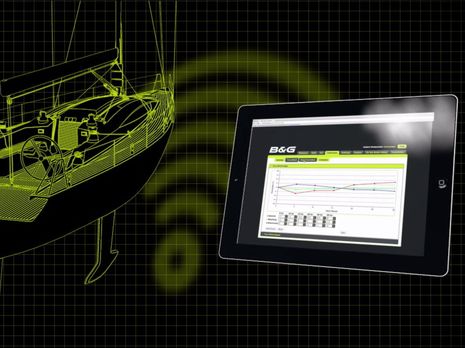 What’s different is that the actual physical processor remains the same and apparently you can upgrade to a higher level via a software update. Previously the PCB would have to be swapped. The setup has been dramatically simplified by including a web server in the CPU box. You can use a computer or (if you have the GoFree WiFi or your own router) a tablet to perform functions such as set-up, calibration, commissioning but also backup/restore and diagnostics. You can expand the capabilities of the processor by adding expansion modules. The current list includes a 3D motion module, a barometer module, a network alarm module, a serial expansion module and an analogue value module.
What’s different is that the actual physical processor remains the same and apparently you can upgrade to a higher level via a software update. Previously the PCB would have to be swapped. The setup has been dramatically simplified by including a web server in the CPU box. You can use a computer or (if you have the GoFree WiFi or your own router) a tablet to perform functions such as set-up, calibration, commissioning but also backup/restore and diagnostics. You can expand the capabilities of the processor by adding expansion modules. The current list includes a 3D motion module, a barometer module, a network alarm module, a serial expansion module and an analogue value module.
The “basic” Hydra level has NMEA 2000, dual NMEA 0183 and Ethernet interfaces to integrate with your computers and other navigation equipment. It supports wind heel compensation, and has a special Performance Wind Filter that aims to optimise wind angle stability. It also has an advanced MOB function which keeps a dead reckoned position of the MOB based on tide or as as updated via AIS SART. It supports most expansion modules and many of B&G’s existing sensors. In addition, the processor provides advanced MOB function with dedicated MOB button input and dead reckoning of relative MOB position, allowing for tide, based on the initial MOB position or as updated via AIS SART with compatible equipment.
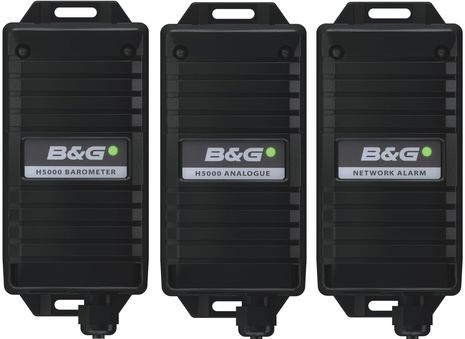 The next level, Hercules, is specifically designed for racing yachts, adding more accurate data and more race specific features. If you add a “3D Motion Expansion Module” you get a motion compensated wind value — ie. it compensates for rolling, pitching and yawing. It would be interesting to compare a Hercules system with this module to a system equipped with the Airmar PB200 — which Dan Corcoran reported as motion compensated as well. The H5000 also allows you to upload polar table data to the CPU that provides target boat speed, target wind angles and performance monitoring. It also allows heel/linearity correction of boat speed and increased sensitivity of boat speed data to real accelerations / decelerations by better filtering. Hercules also provides enhanced communication, Polar table configuration and Start Line information.
The next level, Hercules, is specifically designed for racing yachts, adding more accurate data and more race specific features. If you add a “3D Motion Expansion Module” you get a motion compensated wind value — ie. it compensates for rolling, pitching and yawing. It would be interesting to compare a Hercules system with this module to a system equipped with the Airmar PB200 — which Dan Corcoran reported as motion compensated as well. The H5000 also allows you to upload polar table data to the CPU that provides target boat speed, target wind angles and performance monitoring. It also allows heel/linearity correction of boat speed and increased sensitivity of boat speed data to real accelerations / decelerations by better filtering. Hercules also provides enhanced communication, Polar table configuration and Start Line information.
The highest level, Performance, is meant for complex yachts that have items such as dual wind sensors, dual rudders, dual or triple daggerboards (providing a calculated depth below the daggerboard). Further functionality delivered by Performance includes the tracking of ground wind speed and direction, Rate of Turn and enhanced polar performance targets.
The H5000 range includes two new displays and carries over two existing ranges. First and foremost there will be a H5000 Graphic display, at around €/$ 1000, that looks like a Triton on steroids — a big bold 5″ colour screen using the same UI style as we already know from Triton. I felt right at home with it, and it was easy to use. Like all B&G displays it uses a fully bonded LCD which means there is no air gap between the front glass and the LCD. This has the advantage that it is impossible for condensation to penetrate and show up on the LCD. Whereas Triton is able to show depth and wind history plots, this also includes special sailing pages, a start line page and the sail steer page that we’ve seen first on the Zeus MFD.
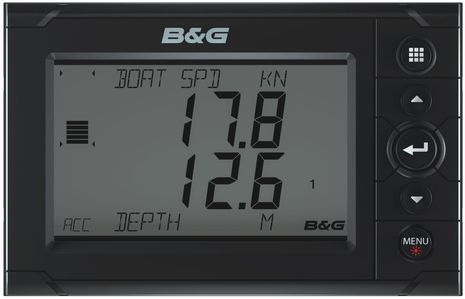 Next up is a new H5000 Race display, using a segmented black/white display that uses a little less power (but not much), is a little cheaper, but more importantly might just match your boat or racing style. It has a small bar graph on the left side of the display that can be used as a visual indicator.
Next up is a new H5000 Race display, using a segmented black/white display that uses a little less power (but not much), is a little cheaper, but more importantly might just match your boat or racing style. It has a small bar graph on the left side of the display that can be used as a visual indicator.
What I also liked that these displays will just drop in for the older H3000 (or even H2000) displays as they have the same physical dimensions, so cutouts as well as the overall feel remain the same. The H5000 Race display will look familiar for H3000 owners but I guess that a lot of owners will prefer then new H5000 Graphic display, which boasts a very bright 5″ color display. With their fully bonded (no condensation) graphical displays the data that can be shown is much more useful. The H5000 graphic display copies the sail steer and start line pages that we know from the Zeus MFD and the windplot display seen on the Triton T41.
The H5000 system also supports the existing HVision 10/10, 20/20, 30/30 and 40/40 mast displays with prices from 500 to 4000 €/$, with more functionality than H3000 did as the new processors can send alternating values (Hydra) or even dynamic sets of data (Hercules, choosing automatically beween pre-start, upwind, reaching and downwind) and 10 Hz update (with Hercules.)
The analogue displays were updated to NMEA 2000 / Simnet a few years ago for use with H3000, and as they are classically styled they just carried over.
The H5000 autopilot shares the hardware with the recent Simrad AC70 computer but runs B&G software which offers dedicated sailing steering modes – gust response, recovery and high-wind response. I guess most sailors won’t miss the removed fishing patterns… B&G claims excellent response for sailing boats, and a win in the latest Vendee Globe.
There is also a new controller that I liked as it is almost as small as the Triton controller but still includes a small B&W LCD display. I asked whether you could mix and match, and use the new controller with a Simrad autopilot computer, but my feedback is that this is not supported.
I’m sure some people out there wouldn’t mind if Santa brought them a H5000 system… Alas that won’t happen as the product availability is still one or two months out.


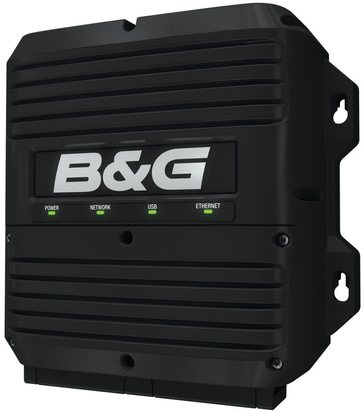

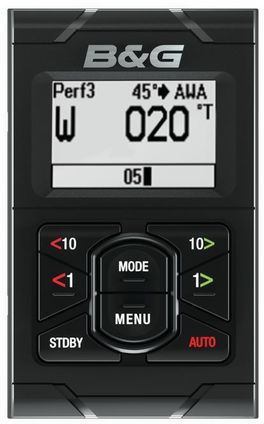
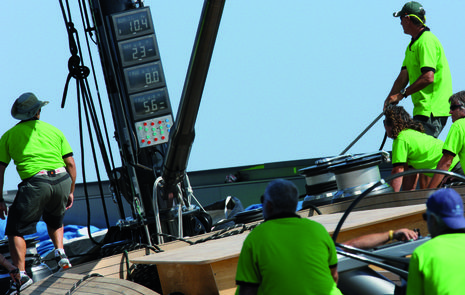











Yes, it would be interesting to compare Hercules to the PB200 (on my Breeze Pleeze).
Great entry Kees
I don’t think the Zeus mfds have a start line page? Or have I not found it yet?!
Hi Tim, you’re right — Zeus (at least version 1) did not include this. Let’s see what Zeus2 brings, and I will fix the entry.
I am surprised to read the B&W display only uses a little less power. Sure about that?
As I re-read your entry, I am salivating over all those features. Many of those features, case in point the correction of boat speed, contribute towards getting an outrageously accurate true wind (Sailing Wind)
Kees, does B&W use their precise correction of sensor measurements to more accurately determine set & drift, while under sail, as well?
Hi Dan,
B&G didn’t release an official power consumption figures, but I used my old screen consumption test: if the display stays cold it’s good, and my hand couldn’t even register a difference in ambient temperature when I saw the Graphic display at METS. My guess is that the consumption will be slightly above the existing Navico IS-20 (rated at 1.3 W max) and IS-40/Triton (rated at 1.8 W max). I say slightly above because of the bigger screen and the increased CPU power. We’ll see when the definitive consumption data comes in.
As to your question on how they determine set & drift, I am hypothesizing a bit here, but certainly with Hercules you have very accurate Speed Through Water (compensated boat speed) which together with a good compass can be compared with the data from a GPS, delivering set & drift. That is exactly the sort of vector math that is quite simple but only B&G shows this on displays.
The B&G Zeus SailSteer page that was referenced by Tim also shows a tidal vector. Garmin showed a comparable display at METS this as well, so we can see how important Furuno and Raymarine think the sailing market is by how quickly they catch up.
has anyone seen a product comparison with WTP3?
what about pros/cons of CanBus?
I think that Raymarine has been doing Set & Drift calculations for many years. In fact, Dan mentioned it long ago when describing his boat’s electronics:
https://panbo.com/features/DanC40Sail.htm
Then again, in my experience this calculation is often sketchy because relatively small errors in boat speed and heading can produce large errors in set and drift.
I suspect that there’s a lot about the ambitious H5000 system that won’t be clear until the manuals come out and the products ship. I doubt, for instance, that the H5000 autopilot only uses NMEA 0183 as the launch page suggests. Though I guess that is possible even with an N2K Pilot Controller since the central CPU unit seem capable of handling all sorts of input and output protocols.
One thing that does seem obvious from the bezel styling and details like the top right Home page button is that these displays may also come out as accessories to the new Simrad NSO and NSS evo2 gear.
https://panbo.com/archives/2013/11/simrad_nss_evo2_multi-touch_7-inch_to_16-inch_and_beyond.html
Finally, anyone else notice that at $1,100 retail, the 5-inch Graphic Display costs almost as much as FOUR of the 4.3-inch Elite-4 fishfinder/plotters discussed last week?
After adding a solid state compass and carefully calibrating speed, the Raymarine provided a very good set & drift while motoring, but not under sail.
As there is no option to enter corrections for leeway at various apparent wind angles and speeds, IMO the E-80 calculates set & drift no different sailing then when motoring.
Is the B&G different?
I received some feedback from a support manager working with Navico:
I’ve asked whether leeway is considered for set + drift, answer not in yet.
I’m seriously tempted by the H5000 system. I’ll be anxiously awaiting publication of the manuals.
I really like the idea of web-based configuration and calibration of the instruments, and the ability to do motion compensation of speed and wind data. Here’s the question: Do you need to use the H5000 displays or, since this is an NMEA2000 system, can the processor spit out data to Triton or even Raymarine i70 instrument displays?
About my only hesitation with the H5000 is the autopilot. I’m sure the B&G is very good, but is it as good as the Raymarine Evolution with it’s 9-axis motion sensor?
Hi Jeff,
My information is that you can use ‘normal’ N2K displays but that they generally are not capable of putting the high update frequency to the same use as the H5000 displays, and of course they can only display the data fields that they are designed for.
No matter what I started typing about the APs, I ended up typing something very subjective so I will refrain from answering that. I will say that 9-axis motion sensors are very cheap now. Digital motion sensors were made reliable and cheap through their use in car airbag sensors, and smartphones have accelerated this trend.
I think its what is done with the data that distinguishes the autopilots. I think we have to wait to see what B&G does with the data going into the autopilot. There is a hint suggesting that the B&G autopilot handles sea state differently than the regular SIMRAD autopilot or the Raymarine Evolution pilot. The B&G pilot is specific to high performance sailing, while the other pilots are more for what I guess we can call average sail and power boats.
There is an interesting blog in wavetrain:
http://www.wavetrain.net/techniques-a-tactics/551-heavy-weather-helming-sculling-waves
Hi Kees,
intertial sensors are indeed “cheap as chips” right now. I just wonder which of the current generation of autopilots have them and – far more importantly – are making good use of the data.
Adding a rate gyro to my circa 2007 Raymarine S3 turned it from an unimpressive device into a really nice helmsman, and that was a very simple gyro, probably only one axis. The new Raymarine advertises a nine axis sensor, but they don’t say what they are doing with the data. The Simrad/B&G pilots have access to 3-axis data, but again it’s not clear what sort of algorithms exist to use the data. The new B&G H5000 pilot also has access, via NMEA2000, to three axis data, and they advertise special a heavy weather mode, but again no detail.
Has anyone, for example, built an autopilot that can steer an “S” course up and down waves?
The most tempting for me is that the H5000 will happily feed its data over wifi to computers, phones and tablets. Combined with a lower cost then its predecessors this might finally open a path for low cost 3rd party applications for performance tuning. To get anything out of the H3000 I have at the moment would take a $150 usb cable.
Is there any reason why one couldn’t use a Triton MFD with the H5000 instead of a 20/20 display?
Mike,
Yes you can use Tritons (or even any other NMEA2000 data display) with H5000.
Kees, worth noting that H5000 is pretty dependent on Navico’s source selection. The H5000 CPU is outputting boat speed and wind data in the standard PGNs but some displays may be confused by the multiple sources of data. Triton displays obviously handle this nicely anyway but I have no idea how well an i70 would work. Might just need extra tweaking.
Also worth noting that H5000 generates data the Triton doesn’t know about, e.g. polar data (target boatspeed, etc). Triton displays cannot show these higher level functions.
Actually I think it can show most of the h5000 data types as most of them were in H3000 bridged using the original Zeus. I am sure there are a few exceptions. You should probably not set damping or do auto source selection from triton in an H5000 system.
Looking at installing a Hercules level H5000 to replace the ca 2002 Hercules/Hydra system on a classic yawl that I club race inshore and cruise casually, but have dreams of sailing from SFBay back to Chesapeake. Plethora of heading/Motion detectors and how they are used has me a bit amused/confused.
Please chime in if you have a better understanding, here’s the plan:
Basic parameters: (no particular calculation needed, can be direct display, speed & AWA/AWS will be better if calibrated in Hercules)
COG/SOG from N2K @ 10 Hz GPS (planning ZG100 on stern Rail)
Heading & Rate from N2K @ 10 Hz (Maretron SSC300, not to go into the B&G compass swamp)
Boat speed calculated from port/starboard bilge paddlewheels rate.
AWA & AWS from Masthead 213 unit over analog to Hercules
Computed: (Hydra level availability)
TWA, TWD, and TWS from vectors of speed/AWS/AWA/Heading
Tide rate and Tide Set from heading/speed/cog/sog
Refined computation: (Hercules level)
Target Wind angle & Target boat speed from Polar table/AWA/AWS
“Smoothed” TWA, TWS, TWD from integration of Motion control signals.
Laylines & Starting line with Tide correction
Not sure what differences are between:
H5000 $1000 3 axis motion sensor part 000-11551-001
and the “WTP3 3D Motion sensor: http://www.bandg.com/en-GB/Products/WTP3-3D-Motion-Sensor/
and why one would be preferred over another?
I have room for a Zues3 and two triton2’s over the companionway of my J/109.
Any thoughts if a Zues3 and H5000 wouldn’t be a better choice? (I don’t have the h5000 CPU’s, but may add in the future after my old ockam reaches end of life)
Is B&G H5000 graphic display and Triton2 graphic display capabilities for sailors essentially identical?
Dan, the T2 displays will show nearly all H5000 data. I don’t think the T2 has starting line feature simply due to the smaller screen.
The H5000 GFD is rectangular and a nice format like the old FFD’s vs the Triton
Triton2 Display Size
4.1″
Resolution
320 x 240
Power Consumption
1.0 Watts (Min), 1.9 Watts (Max)
H5000 GFD
5″ diagonal
480×270, 1.9-2.3 watts
If your goal is to have an intermediate system with NMEA2000 based sensors then go with the Triton and don’t bother with the H5k, unless you are willing to replace the Masthead sensor and add the motion detection. The H5000 is designed to use analog sensors and do the high speed processing of them to give faster than NMEA updates which would matter for an Autopilot in challenging conditions, but not so much for day sailing.
This is for a j109 sailboat, mostly used for racing phrf and one design, it has a tall b&g masthead sensor, signet paddlewheel, nmea0813 Airmar depth sensor, simrad rc42 rate compass, simrad rc36 rate compass, AP26 autopilot head, AC20 autopilot, zues T12, navico GPS 1330,Simrad GPS GS25, GoFree, ockam brain, and 4 matrx 007 displays. The displays are very hard to read or I would leave this as a project for another year.
Dan, you have parts in place that justify using an H5000 CPU, which will give you much better data than a pure n2k system, e.g. you can cal True Wind Angle with H5000 similar to the Ockam. I am happy to brainstorm the system design with you. Ben has my contact info.
The H5000 Motion CPU is an add-on and not required for a basic H5 system.
Terrific, Ben has my contact info als, or use my fn followed by @servicespan.net